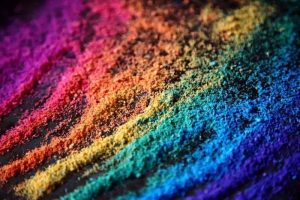Calcium carbonate is an odorless and tasteless white powder. It is one of the most widely used inorganic fillers. Its molecular formula is CaCO3 and its relative molecular weight is 100.09. As a high-quality filler and white pigment, calcium carbonate has the characteristics of cheap price, abundant resources and high grade, and is widely used in coatings, plastics, rubber and other fields.

Powder coating is a solvent-free, volatile-free solid coating, which is one of the most promising coatings.
Calcium carbonate is used in powder coatings, which can achieve excellent properties such as high powder coating rate, high spraying area, no sand particles, and no heavy metals.
Calcium carbonate, non-toxic, non-irritating, odorless, white, dry without crystal water, soft powder, Mohs hardness No. 3. Precipitated calcium carbonate is calcium carbonate produced by chemical methods, the average particle size is between 0-6um, and the whiteness is above 95%. This is the calcium carbonate usually used in powder coatings.
By changing the production process of calcium carbonate, various fine and ultrafine calcium carbonates such as cubic, spindle, spherical, needle-like and chain-like can be produced.
Heavy calcium carbonate is made of natural calcite, limestone, chalk, and shells. It is ground mechanically to a certain fineness. Due to the impure nature of this product, it is limited in the application of powder coatings. .
Activated calcium carbonate is the surface treatment of calcium carbonate powder to form a surface modification layer, thereby improving the surface properties of calcium carbonate powder. Depending on the surface treatment active agent.
It can be divided into two categories: one is treated with stearic acid, calcium stearate, resin acid, rosin acid, polybutadiene, etc.; the other is treated with phthalate coupling agent, phosphate ester coupling agent, Silane coupling agent, etc., so due to the difference in particle size and surface treatment agent, various series of products are formed.
The role of calcium carbonate in powder coatings
A. It acts as a skeleton in powder coatings, and their filling can increase the thickness of the coating film and improve the wear resistance and durability of the coating.
B. It can reduce the cost of coatings. Generally, the price of calcium carbonate is lower than that of other inorganic fillers. The amount of calcium carbonate added in coatings is relatively large, so adding calcium carbonate can reduce the cost of powder coatings.
C. It can increase the powder coating rate and spraying area of powder coatings. In addition, it does not contain heavy metals, so it is the first choice filler for powder coatings without heavy metals.
The advantages and precautions of the application of calcium carbonate in powder coatings:
1. Calcium carbonate can be used as a filler for high-gloss products, and its gloss is not lower than other fillers.
2. General semi-gloss products can be prepared by directly adding calcium carbonate, without adding B68 matting agent, saving cost.
3. Calcium carbonate itself is also a white inorganic pigment, which can be used in conjunction with titanium dioxide to obtain inexpensive and high-quality products.
4. Compared with several other fillers, calcium carbonate is most suitable for some products that require low heavy metal content, such as baby carriages, children’s toys, etc.
5. Calcium carbonate can increase the coating rate and spraying area of the coating, especially when used in mixed powder.
6. If you are making outdoor weather-resistant products, you must not choose calcium carbonate as a filler.
7. In order to avoid the orange peel on the surface of the coating due to the high oil absorption of calcium carbonate, a little hydrogenated castor oil can be added to the base material.
